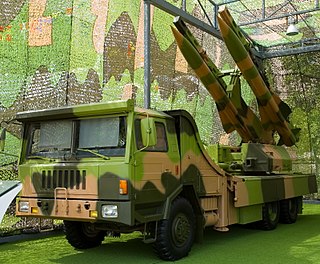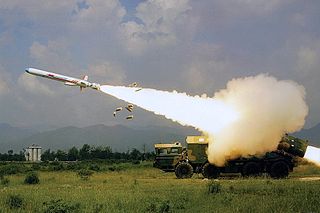
The Rafael Python (פיתון) is a family of air-to-air missiles (AAMs) built by the Israeli weapons manufacturer Rafael Advanced Defense Systems, formerly RAFAEL Armament Development Authority. Originally starting with the Shafrir series, the Shafrir-1 missile was developed in 1959, followed by the Shafrir-2 in early 1970s. Subsequently, the missiles were given the western name of "Python" by the parent company for export purposes, starting with the Python-3 in 1978. Since then, it has been further developed and evolved into the Python-4, Python-5, Derby and also, the SPYDER, an advanced ground-based air-defence system. Currently, the missiles are in service with the armed forces of over fifteen countries from around the world.

The P-15 Termit is an anti-ship missile developed by the Soviet Union's Raduga design bureau in the 1950s. Its GRAU designation was 4K40, its NATO reporting name was Styx or SS-N-2. China acquired the design in 1958 and created at least four versions: the CSS-N-1 Scrubbrush and CSS-N-2 versions were developed for ship-launched operation, while the CSS-C-2 Silkworm and CSS-C-3 Seersucker were used for coastal defence. Other names for this basic type of missile include: HY-1, SY-1, and FL-1 Flying Dragon, North Korean local produced KN-1 or KN-01, derived from both Silkworm variants and Russian & USSR P-15, Rubezh, P-20 P-22.

The S-300 is a series of long-range surface-to-air missile systems developed by the former Soviet Union. It was produced by NPO Almaz for the Soviet Air Defence Forces to defend against air raids and cruise missiles.

The S-125 Neva/Pechora is a Soviet surface-to-air missile system that was designed by Aleksei Isaev to complement the S-25 and S-75. It has a shorter effective range and lower engagement altitude than either of its predecessors and also flies slower, but due to its two-stage design it is more effective against more maneuverable targets. It is also able to engage lower flying targets than the previous systems, and being more modern it is much more resistant to ECM than the S-75. The 5V24 (V-600) missiles reach around Mach 3 to 3.5 in flight, both stages powered by solid fuel rocket motors. The S-125, like the S-75, uses radio command guidance. The naval version of this system has the NATO reporting name SA-N-1 Goa and original designation M-1 Volna.

The Buk is a family of self-propelled, medium-range surface-to-air missile systems developed by the Soviet Union and its successor state, the Russian Federation, and designed to counter cruise missiles, smart bombs and rotary-wing aircraft, and unmanned aerial vehicles. In the Russian A2AD network, Buk is located between the S-200/300/400 systems above and the point defense Tor and Pantsir type systems below.

The HQ-16 is a medium-range surface-to-air missile (SAM) from the People's Republic of China. It is derived from earlier versions of the Russian Buk missile system.

The PL-12 is an active radar-guided beyond-visual-range air-to-air missile developed by the People's Republic of China. It is considered comparable to the US AIM-120 AMRAAM and the Russian R-77.

The S-75 is a Soviet-designed, high-altitude air defence system. It is built around a surface-to-air missile with command guidance. Following its first deployment in 1957 it became one of the most widely deployed air defence systems in history. It scored the first destruction of an enemy aircraft by a surface-to-air missile, with the shooting down of a Taiwanese Martin RB-57D Canberra over China on 7 October 1959 that was hit by a salvo of three V-750 (1D) missiles at an altitude of 20 km (66,000 ft). This success was credited to Chinese fighter aircraft at the time to keep the S-75 program secret.

The HQ-7 is a short-range surface-to-air missile (SAM) from the People's Republic of China. It was reverse-engineered by the Changfeng Electromechanical Technology Design Institute from the French R-440 Crotale SAM. It entered service in the early 1980s.

The Hongdu JL-10, also initially known as Hongdu L-15 Falcon, is a supersonic advanced jet trainer and light combat aircraft developed by Hongdu Aviation Industry Corporation (HAIC). It is used by the People's Liberation Army Air Force (PLAAF) as a lead-in fighter trainer (LIFT).

The HQ-9 is a long-range semi-active radar homing (SARH) surface-to-air missile (SAM) developed by the People's Republic of China. The naval variant is the HHQ-9.

The KS-1 or Kaishan-1, military designation HQ-12 is the first Chinese surface-to-air missile to adopt a phased array radar.

The Guizhou JL-9, also known as the FTC-2000 Mountain Eagle, is a family of two-seat transonic advanced jet trainer and light combat aircraft developed by the Guizhou Aviation Industry Import/Export Company (GAIEC) for the People's Liberation Army Air Force (PLAAF) and the People's Liberation Army Naval Air Force (PLANAF).

The YJ-62 is a Chinese subsonic land-attack and anti-ship cruise missile. It is manufactured by the China Aerospace Science and Industry Corporation Third Academy.

The 250th Air Defence Missile Brigade is a joint tactical unit of Serbian Air Force and Air Defence.

The YJ-83 is a Chinese subsonic anti-ship cruise missile. It is manufactured by the China Aerospace Science and Industry Corporation Third Academy.

The HQ-17 is an all-weather, low to medium altitude, short-range surface-to-air missile system derived from the Tor-M1.

The PL-15 is an active radar-guided long-range air-to-air missile developed by the People's Republic of China.
KD-88 (Kongdi-88) is a standoff land attack missile built by China Aerospace Science and Technology Corporation (CASC). Its export version is called TL-17.
The PL-17 or PL-20 is an active radar-guided beyond-visual-range air-to-air missile developed by the People's Republic of China for the People's Liberation Army Air Force (PLAAF). The missile has claimed range more than 400 km (250 mi) and is intended to target high value airborne assets (HVAA) such as tanker and early warning and control (AEW&C) aircraft.


















